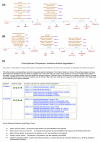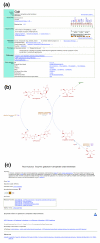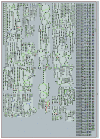MouseCyc: a curated biochemical pathways database for the laboratory mouse
- PMID: 19682380
- PMCID: PMC2745765
- DOI: 10.1186/gb-2009-10-8-r84
MouseCyc: a curated biochemical pathways database for the laboratory mouse
Abstract
Linking biochemical genetic data to the reference genome for the laboratory mouse is important for comparative physiology and for developing mouse models of human biology and disease. We describe here a new database of curated metabolic pathways for the laboratory mouse called MouseCyc http://mousecyc.jax.org. MouseCyc has been integrated with genetic and genomic data for the laboratory mouse available from the Mouse Genome Informatics database and with pathway data from other organisms, including human.
Figures





Similar articles
-
Mouse genome database 2016.Nucleic Acids Res. 2016 Jan 4;44(D1):D840-7. doi: 10.1093/nar/gkv1211. Epub 2015 Nov 17. Nucleic Acids Res. 2016. PMID: 26578600 Free PMC article.
-
Mouse Genome Database (MGD)-2018: knowledgebase for the laboratory mouse.Nucleic Acids Res. 2018 Jan 4;46(D1):D836-D842. doi: 10.1093/nar/gkx1006. Nucleic Acids Res. 2018. PMID: 29092072 Free PMC article.
-
The Mouse Genome Database genotypes::phenotypes.Nucleic Acids Res. 2009 Jan;37(Database issue):D712-9. doi: 10.1093/nar/gkn886. Epub 2008 Nov 3. Nucleic Acids Res. 2009. PMID: 18981050 Free PMC article.
-
Mouse Genome Database: From sequence to phenotypes and disease models.Genesis. 2015 Aug;53(8):458-73. doi: 10.1002/dvg.22874. Epub 2015 Jul 27. Genesis. 2015. PMID: 26150326 Free PMC article. Review.
-
The Mouse Tumor Biology Database: a public resource for cancer genetics and pathology of the mouse.Cancer Res. 2002 Mar 1;62(5):1235-40. Cancer Res. 2002. PMID: 11888882 Review.
Cited by
-
Stoichiometry based steady-state hepatic flux analysis: computational and experimental aspects.Metabolites. 2012 Mar 14;2(1):268-91. doi: 10.3390/metabo2010268. Metabolites. 2012. PMID: 24957379 Free PMC article.
-
Human versus mouse eosinophils: "that which we call an eosinophil, by any other name would stain as red".J Allergy Clin Immunol. 2012 Sep;130(3):572-84. doi: 10.1016/j.jaci.2012.07.025. J Allergy Clin Immunol. 2012. PMID: 22935586 Free PMC article. Review.
-
Mouse genome database 2016.Nucleic Acids Res. 2016 Jan 4;44(D1):D840-7. doi: 10.1093/nar/gkv1211. Epub 2015 Nov 17. Nucleic Acids Res. 2016. PMID: 26578600 Free PMC article.
-
A Mitochondrial Polymorphism Alters Immune Cell Metabolism and Protects Mice from Skin Inflammation.Int J Mol Sci. 2021 Jan 20;22(3):1006. doi: 10.3390/ijms22031006. Int J Mol Sci. 2021. PMID: 33498298 Free PMC article.
-
Advanced stoichiometric analysis of metabolic networks of mammalian systems.Crit Rev Biomed Eng. 2011;39(6):511-34. doi: 10.1615/critrevbiomedeng.v39.i6.30. Crit Rev Biomed Eng. 2011. PMID: 22196224 Free PMC article. Review.
References
-
- Waterston RH, Lindblad-Toh K, Birney E, Rogers J, Abril JF, Agarwal P, Agarwala R, Ainscough R, Alexandersson M, An P, Antonarakis SE, Attwood J, Baertsch R, Bailey J, Barlow K, Beck S, Berry E, Birren B, Bloom T, Bork P, Botcherby M, Bray N, Brent MR, Brown DG, Brown SD, Bult C, Burton J, Butler J, Campbell RD, Carninci P, et al. Initial sequencing and comparative analysis of the mouse genome. Nature. 2002;420:520–562. doi: 10.1038/nature01262. - DOI - PubMed
-
- Baldarelli RM, Hill DP, Blake JA, Adachi J, Furuno M, Bradt D, Corbani LE, Cousins S, Frazer KS, Qi D, Yang L, Ramachandran S, Reed D, Zhu Y, Kasukawa T, Ringwald M, King BL, Maltais LJ, McKenzie LM, Schriml LM, Maglott D, Church DM, Pruitt K, Eppig JT, Richardson JE, Kadin JA, Bult CJ. Connecting sequence and biology in the laboratory mouse. Genome Res. 2003;13:1505–1519. doi: 10.1101/gr.991003. - DOI - PMC - PubMed
Publication types
MeSH terms
Grants and funding
LinkOut - more resources
Full Text Sources

